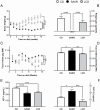Differential Effects of Sulfur Amino Acid-Restricted and Low-Calorie Diets on Gut Microbiome Profile and Bile Acid Composition in Male C57BL6/J Mice
- PMID: 33106871
- PMCID: PMC8514071
- DOI: 10.1093/gerona/glaa270
Differential Effects of Sulfur Amino Acid-Restricted and Low-Calorie Diets on Gut Microbiome Profile and Bile Acid Composition in Male C57BL6/J Mice
Abstract
Diet can affect health and longevity by altering the gut microbiome profile. Sulfur amino acid restriction (SAAR), like caloric restriction, extends lifespan. But, its effect on the gut microbiome profile and functional significance of such effects are understudied. We investigated whether SAAR alters the gut microbiome profile and bile acid composition, an index of microbial metabolism. We also compared these changes with those induced by a 12% low-calorie diet (LCD). Male 21-week-old C57BL6/J mice were fed control (CD; 0.86% methionine), SAAR (0.12% methionine), and LCD diets (0.86% methionine). After 10 weeks on the diet, plasma markers and fecal microbial profiles were determined. SAAR mice had lower body weights and IGF-1, and higher food intake and FGF-21 than CD mice. Compared to SAAR mice, LCD mice had higher body weights, and lower FGF-21 and food intake, but similar IGF-1. β-Diversity indices were different between SAAR and LCD, and LCD and CD, but not between CD and SAAR. In groupwise comparisons of individual taxa, differences were more discernable between SAAR and LCD than between other groups. Abundances of Firmicutes, Clostridiaceae, and Turicibacteraceae were higher, but Verrucomicrobia was lower in SAAR than in LCD. Secondary bile acids and the ratio of secondary to primary bile acids were lower in SAAR than in LCD. SAAR favored bile acid conjugation with glycine at the expense of taurine. Overall, SAAR and LCD diets induced distinct changes in the gut microbiome and bile acid profiles. Additional studies on the role of these changes in improving health and lifespan are warranted.
Keywords: Clostridiales; Firmicutes; Lifespan; Methionine restriction; Sulfur metabolism.
© The Author(s) 2020. Published by Oxford University Press on behalf of The Gerontological Society of America.
Figures




Similar articles
-
Pharmacological recapitulation of the lean phenotype induced by the lifespan-extending sulfur amino acid-restricted diet.Aging (Albany NY). 2025 Apr 7;17(4):960-981. doi: 10.18632/aging.206237. Epub 2025 Apr 7. Aging (Albany NY). 2025. PMID: 40202448 Free PMC article.
-
Dietary Methionine and Total Sulfur Amino Acid Restriction in Healthy Adults.J Nutr Health Aging. 2023;27(2):111-123. doi: 10.1007/s12603-023-1883-3. J Nutr Health Aging. 2023. PMID: 36806866 Free PMC article.
-
Sulfur amino acid restriction-induced changes in redox-sensitive proteins are associated with slow protein synthesis rates.Ann N Y Acad Sci. 2018 Apr;1418(1):80-94. doi: 10.1111/nyas.13556. Epub 2018 Jan 29. Ann N Y Acad Sci. 2018. PMID: 29377163
-
Disease prevention and delayed aging by dietary sulfur amino acid restriction: translational implications.Ann N Y Acad Sci. 2018 Apr;1418(1):44-55. doi: 10.1111/nyas.13584. Epub 2018 Feb 5. Ann N Y Acad Sci. 2018. PMID: 29399808 Review.
-
The Potential Roles of Very Low Calorie, Very Low Calorie Ketogenic Diets and Very Low Carbohydrate Diets on the Gut Microbiota Composition.Front Endocrinol (Lausanne). 2021 May 14;12:662591. doi: 10.3389/fendo.2021.662591. eCollection 2021. Front Endocrinol (Lausanne). 2021. PMID: 34054731 Free PMC article. Review.
Cited by
-
A "Gut Feeling" to Create a 10th Hallmark of Aging.J Gerontol A Biol Sci Med Sci. 2021 Oct 13;76(11):1891-1894. doi: 10.1093/gerona/glab191. J Gerontol A Biol Sci Med Sci. 2021. PMID: 34245264 Free PMC article. No abstract available.
-
Long term methionine restriction: Influence on gut microbiome and metabolic characteristics.Aging Cell. 2024 Mar;23(3):e14051. doi: 10.1111/acel.14051. Epub 2024 Jan 26. Aging Cell. 2024. PMID: 38279509 Free PMC article.
-
Exclusion of sulfide:quinone oxidoreductase from mitochondria causes Leigh-like disease in mice by impairing sulfide metabolism.J Clin Invest. 2024 Jun 13;134(15):e170994. doi: 10.1172/JCI170994. J Clin Invest. 2024. PMID: 38870029 Free PMC article.
-
Pharmacological recapitulation of the lean phenotype induced by the lifespan-extending sulfur amino acid-restricted diet.Aging (Albany NY). 2025 Apr 7;17(4):960-981. doi: 10.18632/aging.206237. Epub 2025 Apr 7. Aging (Albany NY). 2025. PMID: 40202448 Free PMC article.
-
Gut microbiota bridges dietary nutrients and host immunity.Sci China Life Sci. 2023 Nov;66(11):2466-2514. doi: 10.1007/s11427-023-2346-1. Epub 2023 Jun 5. Sci China Life Sci. 2023. PMID: 37286860 Free PMC article.
References
-
- McCay CM, Maynard LA, Sperling G, Barnes LL. The Journal of Nutrition. Volume 18 July–December, 1939. Pages 1–13. Retarded growth, life span, ultimate body size and age changes in the Albino rat after feeding diets restricted in calories. Nutr Rev. 1975;33:241–243. doi:10.1111/j.1753-4887.1975.tb05227.x - DOI - PubMed
Publication types
MeSH terms
Substances
Grants and funding
LinkOut - more resources
Full Text Sources
Miscellaneous

